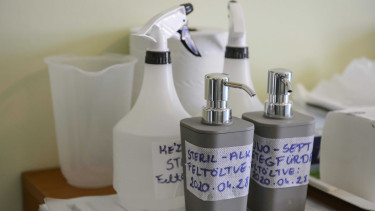The peak of COVID-19 test positivity and everything that comes with it in Hungary

Coronavirus spreads faster than a year ago

The tables below show how the changes in the number of daily new confirmed COVID-19 cases, hospitalisations and the number of ventilated Covid patients in 2021 and 2020.
In the top chart we compared the figures of 18 November to one, two, three, and four weeks earlier. The second chart shows the week-on-week changes. The red cells make it evident that the epidemiological situation has been worsening at a more alarming rate in almost every aspect than in the base period.


Estimating the peak of the positivity rate
To demonstrate the huge difference a single daily test positivity number can make, Pártos created two graphs and two scenarios.
The one on the left shows a projection using daily percent positive data, while the right-hand chart shows the estimates based on 3-day and 7-day averages of the positivity rate.
As you can see the difference is huge. And these are only two scenarios and not even extreme ones.
The graphs were originally created on 18 November and used two hypothetical percent positive figures as today's release.
A slight drop in the number of COVID-19 tests performed and an almost flat number of new cases were to result in a 25% positivity rate. In that case the peak in the daily test positivity rate was estimated to be reached around 9 or 10 December (orange curve on the first graph on the left). (The R2 is around 95% in this case, but it is not much lower when the peak is estimated at 50% or 60%. As regards the 3-day and 7-day averages, this would imply a peak around 12 or 13 December around 32 to 33%. This was the bullish scenario.

The other hypothetical scenario was fewer than 40,000 tests but more than 12,000 new cases, which would have resulted in a 31% percent positive. In that case the daily positivity rates would not have peaked by 15 December (they most likely will, though) and the 3-day and 7-day averages would have gone up to around 35%. This was the bearish scenario.

Why are percent positive data important?
Pártos thinks that a lot more people with coronavirus infection have been hospitalised than what the official figures show, because PCR testing cannot keep up with the pace of the spread of the virus, hence the official figures (hospitalisations, patients on ventilator, Covid deaths) no longer reflect the reality. Their credibility is back to the autumn 2020 level.
When it comes to the actual number of fatalities we will once again need to rely on the Central Statistical Office (KSH), but we will not have those data for the current ‘wave’ before the middle or the end of March 2022. And this is a highly upbeat estimate. We might not see those figures until AFTER the election (likely to be held in May).
Why is the percent positive important despite the poor quality of the data? Because it entails a host of other vital changes.
Changes in the positivity rate are reflected in the other epidemiological data with a delay:
- new cases – 3 to 5 days
- hospitalisations – 7 to 10 days
- patients on ventilator – 12 to 15 days
- deaths – 18 to 22 days.
How high can Covid fatalities go?
The current number of cases implies around 250 to 300 fatalities which could double in two or three weeks. This translates into 600 deaths per day, and it could be more. The official statistics are likely to show less, about 400 to 450 at most, and then we will have to wait for the stats office until next year.
Pártos also made an estimate using the cumulated test positivity because this way the heavy fluctuations in the daily numbers can be filtered out.
You find every important information in the headline of the graph. Note that the descending section of the curve is wrong. Such a steep fall would occur only if the declining number of new cases was coupled with a rising number of tests, but that will never happen. Consequently, the downward slope will be a lot flatter than this. Why? The fewer cases there are, the fewer tests will be performed and the smaller values will modulate the accumulation downward (the total will change less than the daily figures).

Not that it mattered at that point. If the actual peak in the test positivity will be where it is currently estimated to be, then the peak in Covid deaths will be reached between 5 and 10 January 2022. (As noted before, the official numbers published by the Coronavirus Task Force will not reflect the actual numbers, also because the administration of fatalities will be in a huge backlog. Not enough PCR tests, not enough hospital beds, either.)
Test positivity showed a moderate drop to around 21% today, based on which the cumulated test positivity is expected to peak on 10 December, and the 3-day and 7-day averages on 5 December.
The new test positivity figure brought the peaks not only forward in time but also downward.

Cover photo: Getty Images




